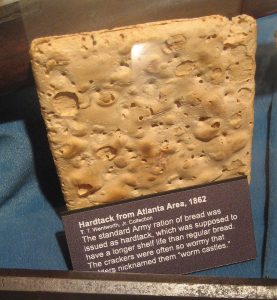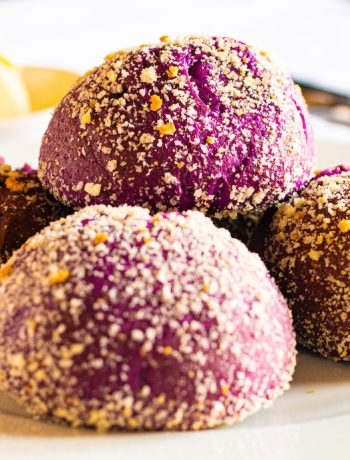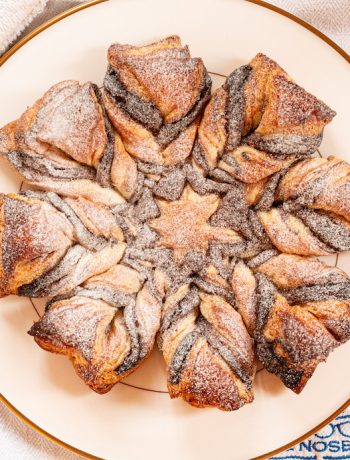Water biscuits, currently enjoyed by the British with cheese and port, have their origins in the truly awful Royal Naval ‘hardtack.’
Hardtack – in use in the English Navy of the 1500s and beyond – was made from a simple baked dough of flour and water. The biscuits were baked four times, usually six months ahead of a voyage. This hardened them to the point of stone – and for good reason. Firstly, hardtack would last for years if kept dry. Secondly, if moisture was present (e.g. like on a ship), then the hardtack would gradually soften over time before becoming rotten and useless. So, having a very hard start point would improve the longevity of the biscuits at sea.

Hardtack – a critical source of energy in the daily rations of naval ratings and officers alike – was often dipped in coffee, beer or seawater to soften it. It was also broken down to make a porridge/gruel-like affair. Hardtack was often known as ‘ship’s biscuits,’ and it was notorious for being one of the most dreaded foodstuffs available from the galley.
Familiarity, however, is hard habit to break, and companies back on dry land would make versions of hardtack for the general population. In 1831, Jonathan Dodgson Carr opened a small mill and bakery in Carlisle, Cumbria. He would bake bread by night and biscuits in the day. When he slept is not recorded.
One of the popular products that Carr made was water biscuits – these were derived directly from naval hardtack. Water biscuits were baked thinner than hardtack so they formed a nice, ‘snappable’ biscuit. At some point, some kind of oil was added to the recipe as a shortening. The Carr’s water biscuits you can buy today are made from flour, water, oil (palm, sadly) and salt.
At the outbreak of World War 1, the Royal Navy, presumably wary of giving their crews actual hardtack and triggering mutiny, turned to Carr’s bakery to supply the ships with water biscuits. Despite their modern refinement, water biscuits still had considerable capacity to stay fresh for long periods at sea.
Making water biscuits is easy once you know at what point to stop adding water – the dough does not behave like a pastry or shortbread dough. This is one of those volumetric recipes where using USA cup measures actually makes sense.
Water biscuits
Ingredients
- 120g (1 US cup) plain flour
- 1 tbsp vegetable oil
- Half tsp Maldon sea salt
- About 50ml (quarter US cup) cold water
Instructions
Combine the flour, oil and salt in a food processor.
With the machine running, slowly add the water until the mixture comes together (It will look grainy rather than suddenly balling like pastry). Stop the machine and check if the dough will form a ball. If not, more water is needed.
Form the dough into a flat round, wrap and chill for 30 mins.
Heat an oven to 220˚C.
Once the dough is rested and chilled, roll it out on a floured surface to about 2mm thick. Alternatively, run it through a pasta machine to the second setting for a really even finish.
On a floured surface, prick the dough all over with a fork or a dough docker. Use a cookie cutter to cut the dough into biscuits the size you like.
Carefully transfer the biscuits to a baking tray lined with floured baking paper or a silicone lining. Bake in the oven for 10–15 mins until just turning golden. Cool on a wire rack.




 (141 votes, average: 3.71 out of 5)
(141 votes, average: 3.71 out of 5)


9 Comments
Andrew
04/03/2021 at 9:28 pmWhat does “form a ball” mean, more precisely? If it makes a round lump, but there are cracks that won’t stick smoothly, is that a ball? And once it’s like that, how to add more water — will kneading it in to the lump cause trouble? Thanks!
Nigel Eastmond
05/03/2021 at 5:57 pmYes, that is a ball. Some cracks are OK, but it if to is falling apart, then you need more water.
Lee
14/03/2021 at 3:55 pmI want to try this recipe but without wheat, e.g. rice flour combination is that possible? What would you suggest?
Nigel Eastmond
15/03/2021 at 10:22 amHi Lee, I have really no idea how to go about making a gluten-free water biscuit, but if I was going to have a go, I think I would use rice flour cut with something like chickpea flour. Pure rice flour may be shatteringly crisp, so softening it a shade with chickpea flour makes some logical sense.
Jjw
29/10/2022 at 4:34 amI’ve had good luck by sprinkling a tsp of plain gelatin in the cold water. Let rest for 5 min. Then add in one egg white, mix well before adding to flour. I also add about 2T of lentil or chickpea flour. Make the dough on the moist/ sticky side. Place in airtight plastic bag and refrigerate overnight to allow time for the gelatin to work. The gelatin and egg white blend will allow you to roll the dough very thin. The thinner, the crisper the cracker.
Nigel Eastmond
01/11/2022 at 10:51 amNice work, Lee.
David Silverman
26/03/2021 at 1:43 pmWe don’t live in the USA now and we don’t have a food processor. Can you offer any hints to make the water biscuits without one. Many thanks.
Dave Silverman
Nigel Eastmond
26/03/2021 at 1:49 pmDavid, the processor is just there to make things easier. As with any dough recipe, you can rub the fat and salt into the flour, and then add the water gradually with kneading until you get a dough.
The Changing Seasons, October 2025 – Touring My Backyard
30/10/2025 at 11:03 pm[…] 1) lemony melt in your mouth cookies, artistically presented by Older Child, 2) 1st attempt at table water biscuits, 3) loaded baked sweet potato, 4) blueberry muffin with streusel on top, 5) smoked salmon on toast, […]